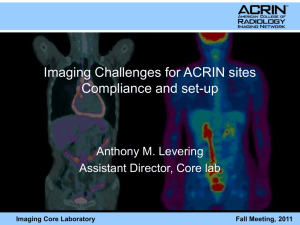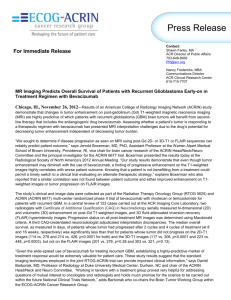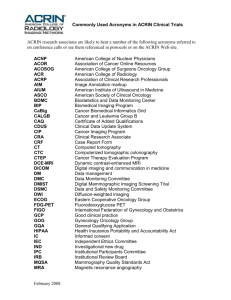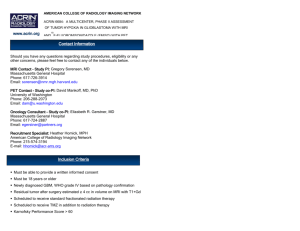Accrual Demonstration Project Presentation - S. Palmer
advertisement
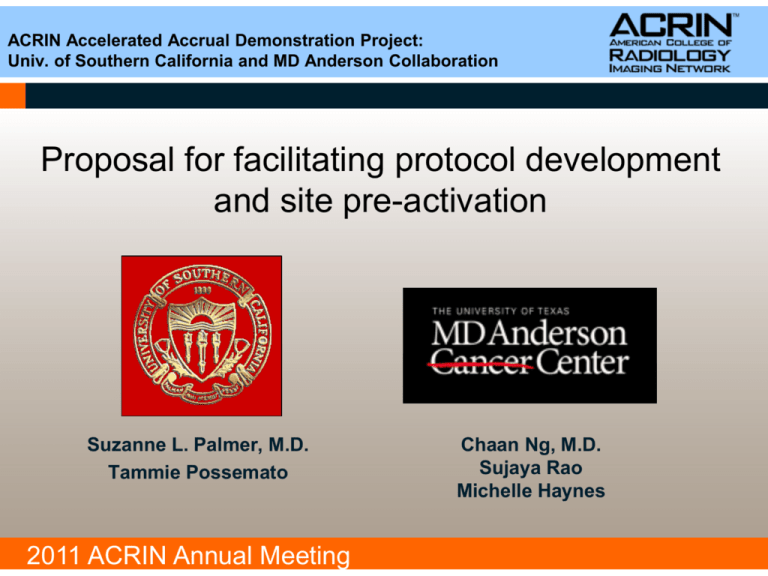
ACRIN Accelerated Accrual Demonstration Project: Univ. of Southern California and MD Anderson Collaboration Proposal for facilitating protocol development and site pre-activation Suzanne L. Palmer, M.D. Tammie Possemato 2011 ACRIN Annual Meeting Chaan Ng, M.D. Sujaya Rao Michelle Haynes #2 pre-activation phase #1 Site Protocol development phase 2011 ACRIN Annual Meeting #1 Protocol development phase STUDY SUMMARY FOR SITE ASSESSMENT SURVEY • Brief Study Summary – – – – Schema Study objectives and end points Patient eligibility and enrollment Associated therapy or tissue biomarker studies – Imaging and equipment requirements – Minimum imaging requirements – Timeline for required imaging – Information needed for the sites to evaluate recruitment potential – Clinical services involved – Study schedule – Reimbursement ACRIN Study #: ACRIN Study Name: Study Contact Information ACRIN Principal Investigator: ACRIN Project Manager: ACRIN schema: Study objectives and end points: Patient eligibility: Basic protocol: Enrollment: Is this study being conducted in conjunction with a with a therapy or tissue biomarker study? SELECT If yes, enter name and number of the study: Minimum imaging requirements: hardware, software and required inclusion studies Pick a Modality Pick a Modality Timeline of required imaging: INFORMATION FOR SITE RECRUITMENT ANALYSIS Clinical services involved: Choose service: If other: Basic Responsibilities: Choose service: If other: Basic Responsibilities: Ancillary services required Laboratory/pathology component: Study procedures/requirements: Other requirements: Reimbursement: Will the cost of the studies required in the protocol be reimbursed by ACRIN? 2011 ACRIN Annual Meeting SELECT #2 Site pre-activation phase STUDY SUMMARY AND SITE ASSESSMENT SURVEY ACRIN Study #: 6690 ACRIN Study Name: Comparison of multiphase contrast-enhanced CT and MRI for diagnosis of HCC and liver transplant allocation Study Contact Information ACRIN Principal Investigator: Christoph Wald, MD, Ph.D, 781-744-8170, christoph.wald@lahey ACRIN Project Manager: Donna Hartfeil, 215 717-2765, dhartfeil@acr.org Individual site assessment • • Site Number: Site Principal Investigator: Site Research Associate (RA): – – ACRIN Schema: HCC diagnosis by baseline CT or MRI (SOC imaging at participating center) – Listing for liver transplantation with HCC-exception points and enrolled in study Local ablative therapy Complement imaging within 30 days of initial imaging (SOC and complement CT and MRI imaging to be performed) Repeat serial imaging every 90 days (CT and MRI) Performed by RA and/or PI Step-by-step Imaging (SOC + complement imaging, no less than 28 days and no more than 60 days after completion of ablation) Transplant surgery Explant pathology analysis Study objectives and end points: The main objective of the ACRIN 6690 trial is to compare modern multiphase contrast-enhanced CT and MRI with pathologic liver findings to establish the performance characteristics of these imaging modalities to accurately detect, diagnose, and stage HCC in patients with chronic liver disease. The CT and MRI examinations acquired within 90 days of transplantation will be compared with the explant pathology findings. The primary analysis will compare CT to MRI results at the lesion level using core laboratory interpretations of the imaging studies; secondary analysis will be performed at the patient level. Patient eligibility: Patients diagnosed with HCC and listed for liver transplant surgery with priority MELD (Model for End-Stage Liver Disease) points based on their cancer diagnosis will participate. Eligible patients include those who may be waiting for a liver to become available from a deceased donor or be scheduled to undergo a living donor adult liver transplant. 2011 ACRIN Annual Meeting • Review of the brief study summary Assess study requirements and match to site’s resources Estimate patient recruitments The Mock Screen – Identify radiology department personnel and conferences – Identify referring clinicians and coordinators – Identify tumor boards and other sources of patient recruitment • If the site assessment is successful, the activation and recruitment phases should go more rapidly. #2 Site pre-activation phase Patient eligibility: Patients diagnosed with HCC and listed for liver transplant surgery with priority MELD (Model for End-Stage Liver Disease) points based on their cancer diagnosis will participate. Eligible patients include those who may be waiting for a liver to become available from a deceased donor or be scheduled to undergo a living donor adult liver transplant. Patients must enroll in the trial within 30 days after initial listing with HCC-exception points to the United Network for Organ Sharing (UNOS) waitlist. Are the eligibility criteria realistic? Select If no, please explain: Individual site assessment • • – – Basic protocol: Each site will image a participant with CT or MRI approximately every 90 days (or earlier) per the OPTN/UNOS HCC-exception point update requirements for their region. This imaging to evaluate disease is considered standard of care. This research trial requires that complement imaging (CT or MRI, whichever imaging was not done as the standard of care) be completed at each 90-day interval. This imaging must be completed within 7 days of the standard-of-care imaging for that time interval. The goal is to compare the CT and MRI examinations acquired within 90 days of transplantation with explant pathology findings. Should a participant undergo local ablative therapy, CT and MRI should be completed no less than 28 days and no more than 60 days after each completed ablative therapy scheme. Enrollment: A total of 440 participants will be accrued to the ACRIN 6690 trial. Number per site was not included in available protocol Is this study being conducted in conjunction with a with a therapy or tissue biomarker study? No Are there any current or pending competing clinical trials at your institution that target the same patient population? SELECT If yes, enter name and number of the competing clinical trial(s): Is the patient population adequate to support this study AND the competing trial(s)? SELECT If No, please explain 2011 ACRIN Annual Meeting Performed by RA and/or PI Step-by-step – • Review of the brief study summary Assess study requirements and match to site’s resources Estimate patient recruitments The Mock Screen – Identify radiology department personnel and conferences – Identify referring clinicians and coordinators – Identify tumor boards and other sources of patient recruitment • If the site assessment is successful, the activation and recruitment phases should go more rapidly. #2 Site pre-activation phase Individual site assessment IMAGING AND EQUIPMENT REQUIREMENTS Minimum imaging requirements: hardware, software and required inclusion studies: Computed Tomography Multi-detector, using a scanner with a minimum of 8 detector rows Power injector 4 phase imaging • • Magnetic Resonance Imaging 1.5T or greater, phase array torso coil, current generation high speed gradients Dual chamber power injector For contrast-enhanced scanning, standard extracellular gadolinium chelates that do not have dominant hepatobiliary excretion (No Eovist) Scanning protocol should be per institutional standards, but should include at a minimum: o Pre-contrast and dynamic post-extracellular-gadolinium T1-weighted (T1W) gradient echo sequence (3D preferable) o T2 (with and without FAT SAT) o T1W in and out of phase imaging Are the inclusion imaging studies feasible for this institution? Select If no, please explain: Do these modalities fall within the institution’s standard of care? Select Will patient recruitment be adversely affected? Select If yes, please explain: Timeline of required imaging: Complement imaging within 30 days of initial imaging Repeat serial imaging every 90 days (CT and MRI) If ablative therapy performed, imaging (SOC + complement imaging, no less than 28 days and no more than 60 days after completion of ablation) Does the study specific timeline conflict with the clinical care timeline? Select If yes, please explain: 2011 ACRIN Annual Meeting Performed by RA and/or PI Step-by-step – – – • Review of the brief study summary Assess study requirements and match to site’s resources Estimate patient recruitments The Mock Screen – Identify radiology department personnel and conferences – Identify referring clinicians and coordinators – Identify tumor boards and other sources of patient recruitment • If the site assessment is successful, the activation and recruitment phases should go more rapidly. #2 Site pre-activation phase MOCK SCREEN FOR PATIENT RECRUITMENT ANALYSIS Overview The Mock Screen is a tool used to determine whether a potential site institution can be successful in recruiting patients for a specific ACRIN study. Generally it is the research associate (RA) who will perform this site specific screen to identify study team co-investigators, sources of patient referrals and make the best estimate of the number of patients who will fit the study eligibility requirements. An aggressive approach to analyzing the potential number of patients that fit the ACRIN study eligibility requirements will determine whether the institution can feasibly be involved in the study. By performing a Mock Screen first, the obstacles specific to the institution may be identified, thus facilitating the decision to apply as an ACRIN study site (or not). Because the Mock Screen identifies the clinical contact pathways for patient recruitment, the study is already organized and ready to accrue, pending approval by the local IRB and other regulatory committees Individual site assessment • • – – INSTRUCTIONS Contact and Clinic Identification The ACRIN Study PI/RA will identify the clinical services they deem necessary for the success of this study. Each institution has their unique organization of clinical services; therefore, the PI/RA must identify clinical services and contact information appropriate for this ACRIN study as outlined below. 1. Identify the radiology subspecialty/division that the study naturally falls into. It is best to select the organ based specialty, rather than the modality based specialty. The decision should be based on which radiology subspecialties have the greatest interaction with the clinical services. Select radiology division from the pull down list. If other is chosen, enter the division in the active field. Enter the name and email address for the division’s administrative assistant in the active fields; Example: Abdominal Contact Name: Veronica Ramirez Email/phone #: vramirez@usc.edu, 442.8721 Choose division: If other: Division Administrative Assistant: Contact Name 2. Email/phone #: Contact the selected division’s administrative assistant for the following information: a. Names, days and times of all interdepartmental conferences that pertain to the ACRIN study patient population and/or disease process being studied Example: Conference Name: Liver tumor board Tuesday/wk Time: 2:30pm Conference Name Conference Name Conference Name b. Select / week: Select / week: Select / week: Time: Time: Time: Names and contact information of the radiologists attending these conferences Example: Radiologist Name: Suzanne Palmer Email/phone #: spalmer@usc.edu, Radiologist Name: Ed Grant Email/phone #: edgrant@usc.edu, Radiologist Name: Radiologist Name: Radiologist Name: Email Address Email Address Email Address 2011 ACRIN Annual Meeting Performed by RA and/or PI Step-by-step – • Review of the brief study summary Assess study requirements and match to site’s resources Estimate patient recruitments The Mock Screen – Identify radiology department personnel and conferences – Identify referring clinicians and coordinators – Identify tumor boards and other sources of patient recruitment • If the site assessment is successful, the activation and recruitment phases should go more rapidly. #2 Site pre-activation phase Estimate Patient Recruitment Information from the Clinical Conferences: 1. The RA should start attending the targeted interdepartmental conference to introduce themselves and present the ACRIN study to the group 2. If the ACRIN study is in conjunction with a cooperative group study (ECOG,GOG, SWOG, RTOG, etc) ask whether the clinical service is involved in the cooperative study. If they are not, ask whether they are interested. If they are not interested, determine why, because if the referring clinical services are not part of the cooperative group study, it is not feasible for the institution to be involved in the ACRIN arm. If the study is in conjunction with a cooperative group study, is the site participating in the cooperative study? Select Individual site assessment • • If no, explain: 3. – – Acquire and review the past 6 weeks of agendas/conference minutes to determine the number of patients who meet the eligibility criteria for the study. This means that the patient must meet not only the tumor type/pathological process being studied, but also meet the diagnosis, imaging and treatment timelines required by the study protocol. a. The protocol schema has the study timeline requirements/restrictions b. The RA must screen whether the institution’s timelines for patient diagnostic and therapeutic procedures correlate to the ACRIN protocol schema. c. Determine the number of eligible patients identified at the conference/month Estimated number of eligible patients for the ACRIN study derived from subspecialty conference: /month Realistic estimate of number of patients based on site specific recruitment history and infrastructure limitations: /month Information from Alternate Resources Clinic patient population review 1. RA to meet one-on-one with the clinical faculty treating the target patient population and their clinic coordinator. a. Present the study and answer any questions b. Assess ability to recruit target patients from the clinic c. Determine approach to patient first contact d. Determine whether there are any competing studies that would take the target patient population out of consideration for the ACRIN study e. Assess ability to facilitate study consents at time of first contact f. Determine the number of eligible patients identified at the clinic/month Estimated number of eligible patients for the ACRIN study derived from subspecialty clinic: /month Realistic estimate of number of patients based on site specific recruitment history and infrastructure limitations: /month Electronic Medical Record survey 1. Perform a filtered search of clinical data bases for the specific disease process. This gives a general idea of the size of the targeted disease population seen at your institution. a. Radiology: Anonymized search for study type that qualify the patient for enrollment b. Pathology: Anonymized search for tumor type that qualifies the patient for enrollment Estimated number of eligible study patients derived from alternative sources (i.e. scheduling calendar): /month Realistic estimate of number of patients based on site specific recruitment history and infrastructure limitations: /month 2011 ACRIN Annual Meeting Performed by RA and/or PI Step-by-step – • Review of the brief study summary Assess study requirements and match to site’s resources Estimate patient recruitments The Mock Screen – Identify radiology department personnel and conferences – Identify referring clinicians and coordinators – Identify tumor boards and other sources of patient recruitment • If the site assessment is successful, the activation and recruitment phases should go more rapidly. Data extraction capability: Examples of sample tables: Important information for the ACRIN Study Group Protocol #: 6695 ACRIN PI: Chaan Ng ACRIN project manager: Bernadine Dunning Site number PI name/contact RA name/contact Target pop available Inc/excl feasible Interest in participating Why no? 4206 Jeffrey Brody jbrody@lifespan.org Wendy Smith wsmith@lifespan.org yes yes no Don’t have the time 4567 Ronald McDonald rmcdonald@restaurant.com Hamburglar hamburglar@restaurant.com no no yes 4317 Suzanne Palmer Spalmer@usc.edu Tammie Possemato tpossema@usc.edu yes no no Site number Estimated # of patients 4206 2/ month 4567 0/month 4317 1/month 2011 ACRIN Annual Meeting Site not participating in GOG 0262 Data extraction capability: Different forms/format examples: Important information for the Study Site Protocol#: 6690 ACRIN PI: Christoph Wald ACRIN project manager: Donna Hartfeil ACRIN 6690 SITE PERSONNEL OVERVIEW RADIOLOGY: P.I. Suzanne Palmer Email/Phone #: spalmer@usc.edu 323-442-8541 Responsibilities: PI responsible for all aspects of the study. RA Tammie Possemato Email/Phone #: tpossemat@usc.edu 323-442-7263 Responsibilities: Assists PI with all aspects of study. CLINICAL SERVICES: Abdominal Transplant John Donovan Email Address: jdonovan@usc.edu Responsibilities: Access to UNOS database, ordering of UNOS recertification CT 90 days. UNOS Contact: Jennifer Pena Email Address: jpena@usc.edu Responsibilities: Notification of MELD Listing Pathology Lydia Petrovich Email Address: lpertrov@usc.edu Responsibilities: Comparison of imaging to explant. Oncology: Anthony ElKhoureiy Email Address: aelkhou@usc.edu Responsibilities: Patient referral Surgery: Yuri Genyk Email Address: ygenyk@usc.edu Responsibilities: Patient referral PATIENT IDENTIFICATION/RECRUITMENT SOURCES: Source Time/Location Contact Liver tumor board Tuesday/wk/ 2pm - UH Jennifer Pena UNOS Website https://portal.unos.org Password 2011 ACRIN Annual Meeting Clinical Services Attending Data extraction capability: Different forms/format examples: Important information for the Study Site STUDY SUMMARY ACRIN Study #: 6690 ACRIN Study Name: Comparison of multiphase contrast-enhanced CT and MRI for diagnosis of HCC and liver transplant allocation Study Contact Information : ACRIN PI: Christoph Wald, MD, Ph.D, 781-744-8170 christoph.wald@lahey ACRIN Project Manager: Donna Hartfeil, 215 717-2765, dhartfeil@acr.org Site Number: 4317 Site PI: Suzanne Palmer, M.D., 323.442.8721, spalmer@usc.edu Site RA: Tammie Possemato, 323.442. 7263, tpossemat@usc.edu ACRIN Schema: Study objectives and end points: The main objective of the ACRIN 6690 trial is to compare modern multiphase contrast-enhanced CT and MRI with pathologic liver findings to establish the performance characteristics of these imaging modalities to accurately detect, diagnose, and stage HCC in patients with chronic liver disease. The CT and MRI examinations acquired within 90 days of transplantation will be compared with the explant pathology findings. The primary analysis will compare CT to MRI results at the lesion level using core laboratory interpretations of the imaging studies; secondary analysis will be performed at the patient level. Patient eligibility: Patients diagnosed with HCC and listed for liver transplant surgery with priority MELD (Model for End-Stage Liver Disease) points based on their cancer diagnosis will participate. Eligible patients include those who may be waiting for a liver to become available from a deceased donor or be scheduled to undergo a living donor adult liver transplant. Patients must enroll in the trial within 30 days after initial listing with HCCexception points to the United Network for Organ Sharing (UNOS) waitlist. Basic protocol: Each site will image a participant with CT or MRI approximately every 90 days (or earlier) per the OPTN/UNOS HCC-exception point update requirements for their region. This imaging to evaluate disease is considered standard of care. This research trial requires that complement imaging (CT or MRI, whichever imaging was not done as the standard of care) be completed at each 90-day interval. This imaging must be completed within 7 days of the standard-of-care imaging for that time interval. The goal is to compare the CT and MRI examinations acquired within 90 days of transplantation with explant pathology findings. Should a participant undergo local ablative therapy, CT and MRI should be completed no less than 28 days and no more than 60 days after each completed ablative therapy scheme. Enrollment: A total of 440 participants will be accrued to the ACRIN 6690 trial. Number per site was not included in available protocol 2011 ACRIN Annual Meeting Significant outcomes, to date: USC results using our tool USC Study Accrual 2010 2011 (as of 9/15) Problems Identified through Mock Screen Solutions/Outcomes 6678 1 3 Difficulty identifying potential patients; multiple competing studies; oncology in charge of study assignment and interested in accruing to competing studies Change in PI. Tumor boards identified and attended; contact made with referring MD’s; potential patients identified at conferences 6682 0 8 Difficulty identifying potential patients; disinterested PI; no communication with clinical services; requirements for imaging not reviewed for access to radiotracer and equipment needs Added PI with interest in gynecologic imaging; regular attendance at weekly tumor boards; imaging road blocks identified and resolved 6685 0 1 Difficulty identifying patients for study; potential patients not interested in participating due to QOL questionnaire; inclusion criteria for N0 neck not well defined; reimbursement inadequate Working with clinical MD’s to recruit patients from clinic and tumor boards; working with ACRIN for clarification of eligibility; attempt to convince USC to drop tithing for this study. 6688 0 3 Difficulty identifying patients for study; multiple competing studies; failure of RA to follow-up on patients identified in tumor boards. Replaced recruiting RA 5 Timing for patient recruitment critical. Knowledge of MELD exception application and any scheduled or completed treatment. RA at weekly conference where patients are listed for MELD exception, and recruited to study with clinical support. One of the first 10 sites to open. 6690 2011 ACRIN Annual Meeting And finally………. Congratulations to Tammie Possemato for being honored as the recipient of the Jo-Ann D’Amato Award! 2011 ACRIN Annual Meeting
